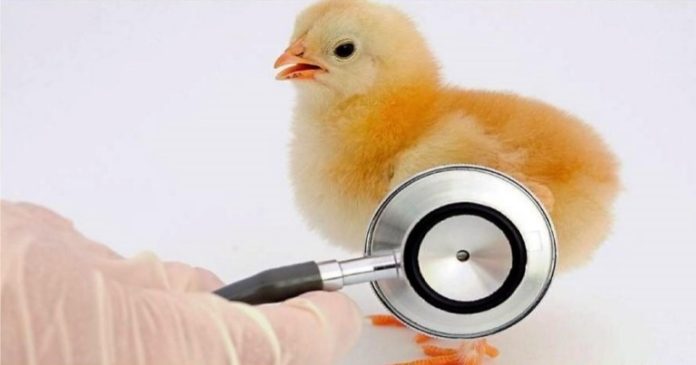Rajendra Moorthy,Nabila Fatima, Santosh Vyas, and Satyam Sharma
Kemin Industries South Asia
Introduction
Duringthe year 2021-22, the Indian poultry industry experienced continued growth, with meat production increasing by 6.86% and egg production by 6.19% (BAHS, 2022). However, in order to maintain profitability in this rapidly growing industry, it is verycrucial to implement and optimize the strategic measures with respect to input and management levels.Biosecurity lapse as a managemental flaw is well perceived to have implications in terms of increased chance of pathogenic incidences. One of the perpetual menaces in poultry production is coccidiosis. However, when it comes to the confrontation of “Coccidiosis”, stringent biosecurity measures take a back seat. The reasons also could be possibly attributed to the scarcity of convincing solutions and limitations in the in-vivo testing using the recommended protocols.
Coccidiosis control strategies in the present-day context could be largely classified into chemoprophylaxis, vaccination,and specificmanagemental practices,Including Biosecurity measures(Attreeet.al. 2021). A foolproof prevention programin field conditionsdemandsa correct combination of all three in a single strategy, to make it successful. This need arises due to the associated challenges
- Limited number of drugs available for disease treatment and prevention
- Requirement for robust execution of shuttle & rotation programs (Chemoprophylaxis)
- Emergence/isolation of novel Eimeria species
- Ubiquitous presence of Eimeria
- Seasonal fluctuation in the prevalence of Eimeria species
Economic ImpactThe estimated global impact of coccidiosis onthe poultry industry is pegged at about £10.4 billion (£7.7–£13.0 billion),where most of the contribution is attributed to a loss in weight gain(Blake et. al., 2020), translating to about ~Rs.16 per chicken.Incidentally, the subclinical manifestation of the disease contributes to about 70 % of the losses (Sorensen et al., 2006).
The observations directly correlatesignificant negative impact on amino acid digestibility and gut health, due to Eimeria species (Kim et. al.,2022).Notably, the occurrence of coccidiosis is generally associated with the predisposition of birds to necrotic enteritis,confirmed through field lesion scoring in regular flocks.The impact could be classified as the expenditure that occurred in either controlling the disease (Vaccination, Biosecurity, Therapeutics),morbidity (Reduced weight, Increased FCR),ormortality. On average, the observations in Indian field conditions would lead us to an assumption of a 2-4 points FCR increment due to the combined prevalence of Coccidiosis along with necrotic enteritis.
Where Does Biosecurity Fit intothe Picture?
Eimeria species infecting chickens areglobally ubiquitous (Reid et al. 2014)and pose a challenge that needs to be simultaneously confronted in the environment (Fig. 1,left sideof dotted line) along with measures at the bird level.The ingestion of sporulated oocyst initiates the infection, followed by further propagation across various stages (Fig. 1, right side of the dotted line). Under favorable environmental conditions, the survivability of oocysts could be as long as 602 days (Fatoba& Adeleke, 2018),leading to repeated orofecal lifecycles in multiple flocks.
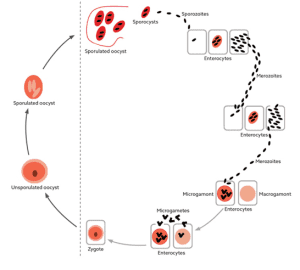
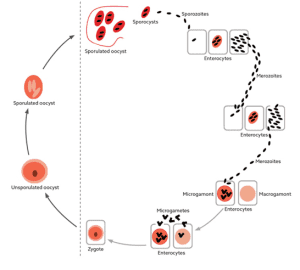
Interestingly, the challenges of malabsorption and performance loss at the level of the gut require more efficient biosecurity interventions which include effective terminal disinfection along with continued operational biosecurity.
The chemoprophylactic measures demand a stringent rotation and shuttle program to make the limited number of molecules effective (Gussem, 2007). Simultaneously,the emergence of novel Eimeriaspecies (Hauck et al., 2019) request actions for prophylactic measures to control coccidiosis. Further, continuous intensification of the production system with increasing stocking densities (Chapman &Rathinam, 2022)would require solutions effective at the environmental level, where the parasite becomes virulent.
Effective Disinfection for CoccidiosisControl
Disinfectants: Maintaining a clean and hygienic environment is essential in reducing the transmission of coccidia. However, the efficacy of conventional disinfectants against Eimerasp.has alwaysbeen a matter of concern. Regular cleaning and disinfectionof poultry houses,equipment, andfeeders with effective solutionsdohelpin eliminatinginfectious oocysts from the environment. Amongst disinfectants (Fig. 2), phenol-


based disinfectants have the property to inhibit the sporulation of coccidia and are widely used as terminal disinfectants.
KemV260®: Unique blend of phenol-based disinfectant
Kemin Industries South Asia Pvt. Ltd., has a phenol-based disinfectant (PD), KemV260®.In this article, its effect on inhibiting E.tenella’s sporulation has beendiscussed. The purified oocysts were treated with PD at 5 mL/L and 10 mL/L doses. After treatment, the oocysts were subjected to sporulation, artificially. In the study, the group that was not treated refers to the control group. After the sporulation process, the oocysts were analyzed for their sporulation stages. As shown in Figure 3, a clear differentiation between unsporulated, sporulating, and sporulated forms were seen.
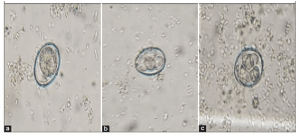
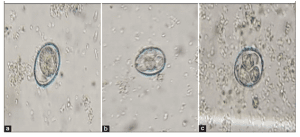
The unsporulated oocysts were observed as intact single cells enclosed within the oocyst wall (Fig. 3a). Sporulating oocysts were characterized by three to four cells that were divided and overlapping each other within the oocyst (Fig. 3b). The fully sporulated stage exhibited well-defined, distinct cells numbering three to four within the oocyst (Fig. 3c). Across all groups, the different stages of oocysts could be distinguished, displaying clear cell differentiation within the oocyst (Fig. 3).
Figure 4 presents the calculated percentages of sporulated, unsporulated, and sporulating oocysts. Each treatment group exhibited different proportions of oocysts in various stages. In the control group, 65% of the oocysts were found to be in the sporulated stage. The group that received a 5mL/L and 10mL/L dose had 38% and 9%, respectively.
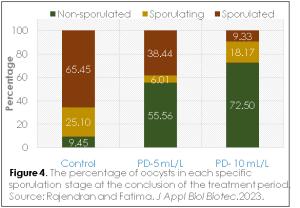
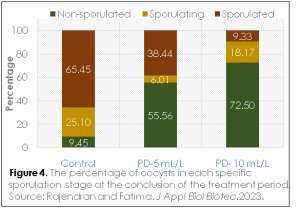
Based on this information, the inhibitory activity (IA) for PD was determined and the results are shown in Figure 5. IA results provide an overall assessment of the effectiveness of the product tested. Higher the IA, the better the efficacy of the product towards inhibiting the sporulation process. The control that was not treated showed an IA of 2.96%. The PD tested at 5 mL/L and 10 mL/L showed an IA of 52.25% and 70.58%, respectively. These results demonstrate the efficiency of the product being evaluated
Effective Sporulation control with Kem V 260®
- The untreated control showed Sporulation Inhibitory Activity (IA) of 2.96%.
- Kem V 260® tested at 10 mL/L,demonstrated Sporulation Inhibitory Activity (IA) of 70.58%.
Conclusion
Coccidiosis infection in the flock could lead to a huge loss. Though several treatment strategies exist, preventing the infection is always the desired choice. With regard to coccidiosis, sporulation inhibition is the prevention route, through which virulence of coccidia is suppressed and PD was found to be effective in inhibiting the sporulation. Hence, the control of oocyst sporulation can be brought about effectively at the shed environment by the effective implementation of Kem V 260®.
References: Available on request
Source: Kemin Industries







